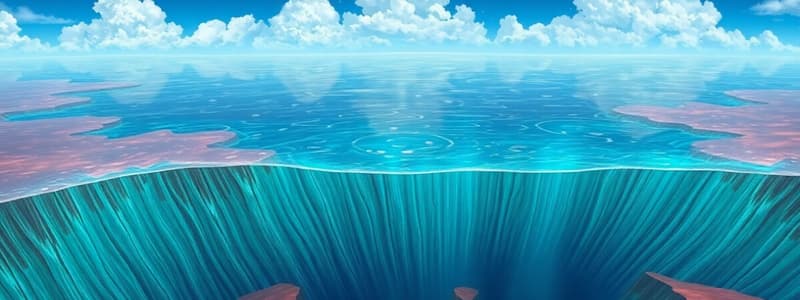Podcast
Questions and Answers
During the initial stages of crustal extension in the formation of an ocean basin like the Red Sea, what happens to the lower and upper parts of the crust?
During the initial stages of crustal extension in the formation of an ocean basin like the Red Sea, what happens to the lower and upper parts of the crust?
- The ductile lower crust stretches, while the brittle upper crust is rifted. (correct)
- Both the upper and lower crust stretch uniformly.
- The brittle upper crust stretches, while the ductile lower crust is rifted.
- Both the upper and lower crust are compressed and thickened.
What geological feature primarily fills the depressions formed by the sliding of crustal blocks during the rifting process?
What geological feature primarily fills the depressions formed by the sliding of crustal blocks during the rifting process?
- Accumulated sediments in lakes and valleys. (correct)
- Metamorphic rock formations.
- Volcanic lava flows.
- Intrusive granite formations.
In the context of the Red Sea's formation, what process occurs when separation of continental blocks is achieved, leading to the creation of new oceanic crust?
In the context of the Red Sea's formation, what process occurs when separation of continental blocks is achieved, leading to the creation of new oceanic crust?
- Folding and faulting of the existing crustal rocks.
- Erosion and weathering of the continental margins.
- Basaltic magma rises to fill the gap between the separating blocks. (correct)
- Subduction of one continental plate under another.
What is the primary cause of evaporite (salt) deposits accumulating in a young marine basin like the early Red Sea?
What is the primary cause of evaporite (salt) deposits accumulating in a young marine basin like the early Red Sea?
Approximately when did the rifting process begin that eventually led to the formation of the Red Sea?
Approximately when did the rifting process begin that eventually led to the formation of the Red Sea?
What is the primary tectonic force driving the separation of the Arabian Peninsula and the African continent in the formation of the Red Sea?
What is the primary tectonic force driving the separation of the Arabian Peninsula and the African continent in the formation of the Red Sea?
What geological process directly contributes to the creation of new oceanic crust along the rift valley in the Red Sea?
What geological process directly contributes to the creation of new oceanic crust along the rift valley in the Red Sea?
Which of the following describes the ongoing geological activity in the Red Sea region today?
Which of the following describes the ongoing geological activity in the Red Sea region today?
Flashcards
Ocean Basin
Ocean Basin
A large body of saltwater that covers part of Earth's surface, formed through tectonic processes.
Rifting
Rifting
The process of the Earth's crust stretching and thinning, leading to the formation of a rift.
Rift Valley
Rift Valley
A low-lying area formed when rifting occurs, where two tectonic plates pull apart.
Seafloor Spreading
Seafloor Spreading
Signup and view all the flashcards
Basaltic Magma
Basaltic Magma
Signup and view all the flashcards
Evaporites
Evaporites
Signup and view all the flashcards
Tectonic Forces
Tectonic Forces
Signup and view all the flashcards
Ongoing Evolution
Ongoing Evolution
Signup and view all the flashcards
Study Notes
Red Sea Formation
- The Red Sea is a modern example of ocean basin formation.
- Formation begins with rifting, progressing to seafloor spreading.
Rift Initiation
- Rift initiation in the Red Sea started around 30 million years ago.
- Tectonic forces separated the Arabian Peninsula and the African continent.
Extension and Rifting
- Continental separation led to stretching and thinning of the Earth's lithosphere.
- This created a rift zone along the Red Sea's future location.
Rift Valley Formation
- The rift zone progressively widened and deepened.
- This formed a rift valley, steadily increasing in width and depth.
Seafloor Spreading
- Magma rose from the Earth's mantle, filling the rift.
- This created new oceanic crust, a process called seafloor spreading.
- New material was added to the seafloor as magma solidified along the rift.
Ocean Basin Formation
- Seafloor spreading caused the newly formed oceanic crust to separate.
- This widened the Red Sea, transforming the rift valley into an ocean basin.
Ongoing Evolution
- Seafloor spreading continues today, widening the Red Sea.
- The rate of widening is a few centimeters per year.
Crustal Development
- During crustal extension, the lower crust stretches (ductile).
- The upper crust is fractured (brittle).
- Crustal blocks slide along fault planes.
- Sediments accumulate in valleys and depressions.
- Basaltic magma fills the gaps between blocks.
Early Stages
- The young Red Sea basin is initially shallow.
- Evaporation of seawater can lead to salt (evaporite) deposits.
Studying That Suits You
Use AI to generate personalized quizzes and flashcards to suit your learning preferences.




